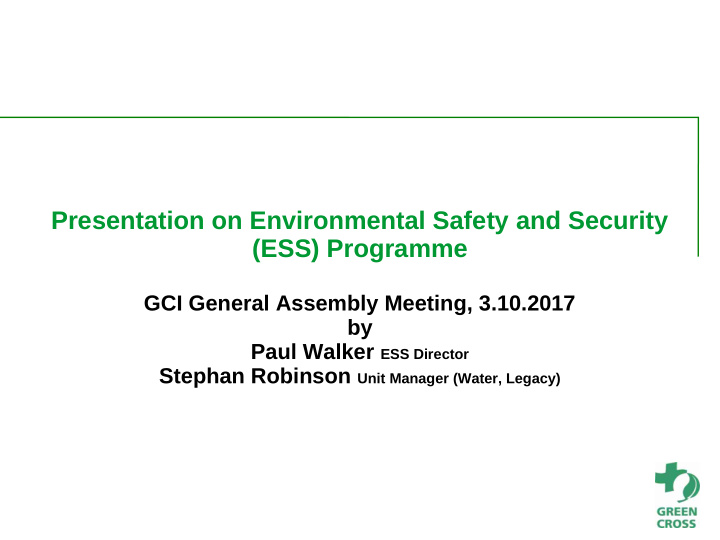



Presentation on Environmental Safety and Security (ESS) Programme GCI General Assembly Meeting, 3.10.2017 by Paul Walker ESS Director Stephan Robinson Unit Manager (Water, Legacy)
ESS mission • The ESS Programme prevents and responds to environmental damages from man-made environmental disasters by – facilitating disarmament processes; – disposing in an environmental sound manner hazardous materials, and – building the needed capacity in a spirit of cooperation and not of confrontation. • To reach these aims, the ESS Programme is divided into two components: – Security: Advocates and facilitates the security, non-proliferation, and safe elimination of weapons of mass destruction, and related materials and systems – Sustainability: Addresses in both preventive and responsive manner pollution of water, land, and air by man-made industrial disasters 2
ESS Achievements 2015-2017 (1) Completed Russian demilitarisation of chemical weapons • Chemical weapons destruction (CWD) conflictual • Government/army vs. local communities • US support to Russia • Experience of Chapayevsk demonstrated the need for public involvement. • GC facilitated in both Russian and American CWD processes. • Prevented derailing of process at several key moments. • Last week, Russia finished destruction of its 40’000 MT stock after 15 years of operations. 3
ESS Achievements 2015-2017 (2) DDT project in FSU area (1) • Regional project in Georgia, Kyrgyzstan and Tajikistan. • The effectiveness of non-chemical alternatives to the use of DDT for disease vector control (malaria, etc.) was demonstrated. • National Integrated Vector Management Programmes relying on non- chemical alternatives to DDT have been adopted. 4
ESS Achievements 2015-2017 (3) DDT project in FSU area (2) • Released last stocks of DDT from health ministries and from various stores are being disposed of: • Total of 361.82 t of DDT and associated wastes have been repacked (78.41 t in Kyrgyzstan, 77.81 t in Tajikistan, 205.60 t in Georgia). • Georgian stocks incinerated in France. • Kyrgyz and Tajik stocks will be disposed of in a follow-on project. 5
ESS Achievements 2015-2017 (4) DDT project in FSU area (3) 6
ESS Achievements 2015-2017 (5) DDT project in FSU area (4) 7
ESS Achievements 2015-2017 (6) Minamata Mercury Convention (1) • About 10-15 million people (including 4-5 million women and children) in over 70 countries globally involved in Artisanal and Small-scale Gold Mining (ASGM) and at high mercury-exposure risk. 8
ESS Achievements 2015-2017 (7) Minamata Mercury Convention (2) • Support to UN Environment during negotiation process and now during implementation phase. • ASGM project of GC Ghana. Objectives include • establishing for one region an analysis of mercury use in ASGM, related environmental impacts and the health situation; • improving the health of affected people within the project community. • Similar project planned for Burkina Faso. • Working with Belarus to establish a national mercury inventory and to prepare the legal basis for early ratification of the Minamata Convention. 9
ESS Achievements 2015-2017 (8) Assessment of impacts by sea-dumped chemical weapons (1) • Hundreds of thousands of tons of chemical ammunition were sea-dumped after WWII. • Assessment of environmental and health impacts in Vieques (Puerto Rico) and the Baltic Sea. • First time evidence that about 23-24 tons of chemical agents were sea-dumped about 10 miles off of Vieques. Study also showed that observed higher cancer risks are linked to former weapons testing at Vieques. • Consequences of the conventional and chemical munition dumps along the shores of the Baltic and North Seas will be significantly worse than in Puerto Rico. • Next steps: • access national archives to have a better understanding of location of sea- dumping areas and of types of materials dumped; and • develop intervention/remediation strategies. 10 10
ESS Achievements 2015-2017 (9) Assessment of impacts by sea-dumped chemical weapons (2) 11 11
ESS Achievements 2015-2017 (10) Improved management of bio-medical wastes (1) • 15 % of bio-medical wastes are hazardous (infectious waste: 10 %, chemical and radioactive waste: 5 %). • Improved bio-medical wastes management protects • healthcare workers; • scavengers and communities near the landfills; • global community through reduced epidemics proliferation (e.g. tourism, travel); and • contains proliferation of dangerous substances which could be used for e.g. dirty bombs or biological attacks. 12 12
ESS Achievements 2015-2017 (11) Improved management of bio-medical wastes (2) • Green Cross project to improve HCW management at Women’s Hospital in Bishkek (Kyrgyzstan) • 99 health care practitioners are working in the hospital. • HCW generated monthly: 90 kg of anatomical wastes, 45 kg of sharps, 3'000 l of liquid chemicals, 20 broken thermometers (containing mercury) • Generate costs savings by replacing sterilisation by chlorinated lime with thermal treatment in an autoclave. • Costs savings fully refunded within a 5 years period the initial investment costs for an autoclave. • Savings can be reinvested into another autoclave at another healthcare facility. • Project to be replicated in Central Asia and West Africa. 13 13
ESS Achievements 2015-2017 (12) Improved management of bio-medical wastes (3) 14 14
ESS Achievements 2015-2017 (13) Nuclear Disarmament • Disarmament of all three Weapons of Mass Destruction (WMD, nuclear, biological, chemical) is interlinked. This is particularly relevant in the Middle East. • Information events in the Middle East with government representatives and media regarding establishment of a WMD Free Zone in the region. This resulted in continuous coverage in the Israeli media and support to this campaign by Israeli members of parliament. • Text for a WMD Free Zone in the Middle East developed. • Supporting nuclear ban (supported by 139 nations, advocacy work in US), CTBTO ratification, Iran deal. 15 15
ESS Achievements 2015-2017 (14) Biological / Chemical Disarmament • Promotion of universality of the CWC and ban of WMDs through CWC Coalition. • Tenth meeting end of 2017, Coalition growing strongly (200 representatives from 80 NGOs in 40 countries). • Seeking to universalize Biological Weapons Convention beyond 179 State Parties (link to WMD Free Zone, bio-medical wastes projects). 16 16
Recommend
More recommend